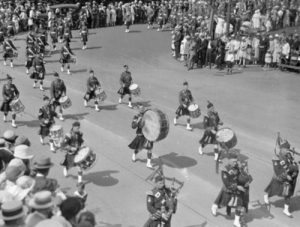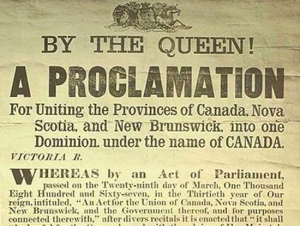Ottawa's Centenary
16 August 1926
In 2026, Ottawa will celebrate its bicentenary, marking two hundred years from when General George Ramsey, 9th Earl of Dalhousie and Governor General of British North America, wrote to Lieutenant-Colonel John By advising By of his purchase of land for the Crown that contained the site of the head locks for the proposed Rideau Canal on the Ottawa river, and the suitability of the locality for the establishment of a village or town to house canal workers. Lord Dalhousie asked Colonel By to survey the land, divide it into 2-4 acre lots and rent them to settlers, with preference to be given to half-pay officers and respectable people. The rough-hewn community, which was subsequently hacked out of a hemlock and cedar forest, was quickly dubbed Bytown. Its name was changed to Ottawa in 1855, and two years later the town was selected as the capital of the Province of Canada by Queen Victoria.
To celebrate the centenary of its founding by Col. By, the City of Ottawa had a week-long, blow-out extravaganza in the summer of 1926. Although the official opening of the celebrations was on Monday, 16 August 1926, the fun actually began two days earlier on the Saturday with a range of sporting events wide enough to please the most die-hard sports fanatic. The Capital Swimming Club staged a centennial regatta in the Rideau Canal opposite the Exhibition Grounds—a daring event given the poor quality of Canal water. Swimmers from across Canada participated with five Dominion championships at stake. At Cartier Square on Elgin Street, four soccer teams competed for the McGiverin Cup with the Ottawa Scottish emerging the victor, beating the Sons of England with a 5-2 score in the finals. Also featured that day were track and field events, cycling, golf, baseball, tennis and a cricket match at the Rideau Hall cricket pitch.
The following day, there was a huge Garrison Church parade involving 3,000 soldiers including local regiments as well as the Queen’s Own Rifles from Toronto and the Royal 22nd Regiment from Quebec City who had been quartered in tents on the grounds of the Normal School on Elgin Street (now the Heritage Building of the Ottawa City Hall). The troops marched from downtown to Lansdowne Park where 15,000 people crowded into the stands for divine services. More than 50,000 people watched the soldiers march through the streets of Ottawa. That evening the band of the “Van Doos” gave a concert that was broadcast from the Château Laurier hotel.
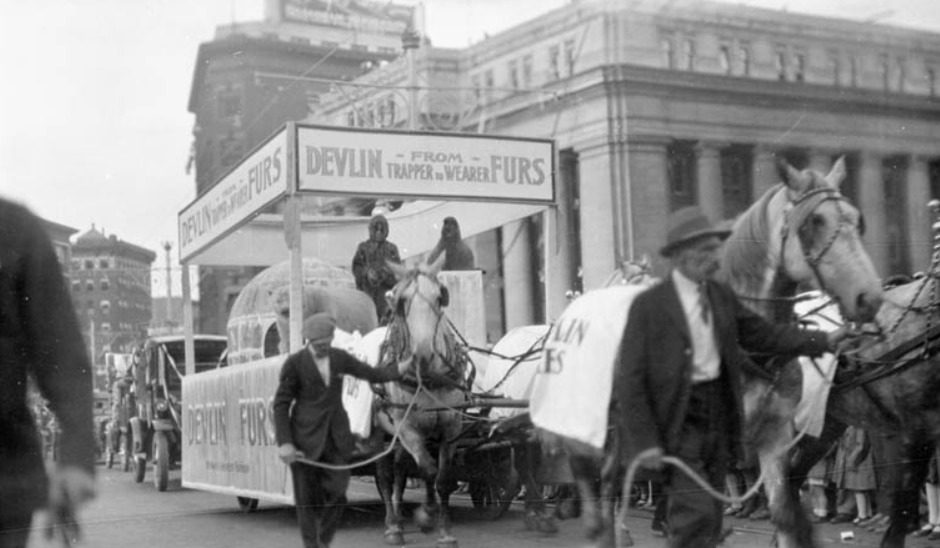 Devlin Furs’ Float, Trades & Industry Pageant, August 1926, Samuel J. Jarvis/Library and Archives Canada, PA-025130.
Devlin Furs’ Float, Trades & Industry Pageant, August 1926, Samuel J. Jarvis/Library and Archives Canada, PA-025130.
The official opening ceremonies took place on the Monday morning on Parliament Hill in front of cheering thousands and “in the shadow of the nearly completed “‘Victory Tower.’” (The name for the Centre Block didn’t officially become the “Peace Tower” until the following year—the 60th anniversary of Confederation.) After much military pomp and pageantry, Sir Henry Drayton, delivered the opening speech in the absence of the Prime Minister, Arthur Meighan. He welcomed visitors to the Capital in the name of the Dominion of Canada. Mayor John Balharrie also greeted visitors and former Ottawa residents who had come home for the celebrations. To symbolized the granting to them of the “freedom” of the city, he released a coloured balloon that carried aloft a four-foot golden key. Messages of congratulations flooded into Ottawa from near and far. Three Governors General—Aberdeen, Connaught and Byng—sent telegrams, as did the Lord Mayor of London, and Jimmy Walker, the controversial and flamboyant Mayor of New York. Civic, provincial and federal politicians from across Canada did likewise.
After the official opening, sporting events occupied the rest of the day. That night, there was a military display and tattoo involving troops from all services in from of 12,000 spectators at Lansdowne Park. The chief feature of the night was the staging of a mock battle scene. As searchlights played over the field, the soldiers re-enacted the crossing of the “Hindenburg” line by Canadian troops in 1918. The mock machine gun action and field bombardment was apparently very realistic. So much so that many veterans experienced flash-backs of their time in the trenches. Also featured that night was a performance of the 1,000 voice Centenary Choir, platoon drills by the Royal 22nd Regiment, and gymnastics displays by cadets.
A highlight of Tuesday, the second day of the Centenary celebrations, was the unveiling of a stone memorial dedicated to Colonel By in a small a park located on the western side of the Rideau Canal just south of Connaught Square opposite Union Station. To the strains of Handel’s Largo, played by the band of the Governor General’s Foot Guard, the memorial, which was covered by a Union Jack, was unveiled at noon. Mayor Balharrie presided. More than 2,000 people witnessed the solemn event. The bronze plaque on the side of the stone, which was intended to be the cornerstone of a much larger memorial, bore the inscription 1826-1926 In Honour of John By, Lieutenant Colonel of the Royal Engineers. In 1826 he founded Bytown, Destined to Become the City of Ottawa, Capital of the Dominion of Canada. This memorial was unveiled in Centenary Year. (A larger memorial was never built. A statue of Colonel By sculpted by Joseph-Émile Brunet was eventually commissioned by the Historical Society of Ottawa and was erected in Major’s Hill Park in 1971.)
At Lansdowne Park, a multi-day western rodeo and stampede commenced with over 200 horses, 100 cattle, and dozens of cowboys from western Canada and the United States. Log rolling competitions took place on the Canal. That evening, an historical pageant was held involving 2,000 actors from service groups, theatre groups, and drama schools. The pageant began with a prologue depicting Confederation with Miss Canada seated on a throne exchanging greetings with Misses Provinces. After pledges of mutual support and loyalty, the provinces curtsied to Canada. This was followed by tableaux representing scenes from Ottawa’s history, including “The Spirit of the Chaudière,” depicting the region before the arrival of Europeans, “The Coming of the White Man,” “Pioneer Settlers,” “The Lumber Industry,” “Bytown and its Early Inhabitants,” “The First Election,” “Naming of the Capital,” “The Fathers of Confederation,” and, a finale where all joined together with the Centenary Choir to sing a closing anthem. The massed 1,000-member Choir accompanied by the G.G.F.G. band also performed a number of popular songs including, O Canada, Land of Hope and Glory, Alouette, Indian Love Song, and, of course, God Save the King.
The pageant got a mixed review. The Ottawa Citizen opined that it provided a “felicitous treatment of the historical episodes chosen for presentation,” but there was “room for improvement.” However, on balance, the pageant was “stimulating and educative.” The dancing was described as “effective.”
After the performance, street dancing was held from 11pm to 2am on O’Connor Street between Albert Street and Laurier to the tunes of two jazz orchestras. With the crush of people, there was little actual dancing though things got a bit better on subsequent nights. With massive crowds downtown, there was some minor trouble. The police arrested a number of young men for setting off firecrackers in the streets. Some had placed “torpedoes” on the street-car tracks that caused “terrific successive explosions” as the trams went over them. Police also acted to curb dangerous driving on the crowded city thoroughfares. Reportedly, louts also molested young women. Generally speaking, however, the street partying was carried out in good humour. A dozen youths organized an impromptu game of leap frog on Sparks Street between Bank and Elgin Streets.
Wednesday, 18 August, was declared a civic holiday by Mayor Balharrie, and more commemorative plaques were unveiled. In addition to non-stop sporting events, rodeo competitions and other fun activities at the Exhibition Grounds, one thousand guests attended a garden party at Rideau Hall. Although Lord Byng had left Ottawa to return to Britain, his term of office as governor general having just ended, he had given permission for the residence to be used as the venue for the civic birthday party celebration. Mayor Balharrie provided a massive four-tier cake decorated with silver foliage and tiny silver cupids. Guests received little boxes of cake bearing the inscription “A souvenir of Ottawa’s Centenary with the compliments of Mayor J. P. Balharrie.”
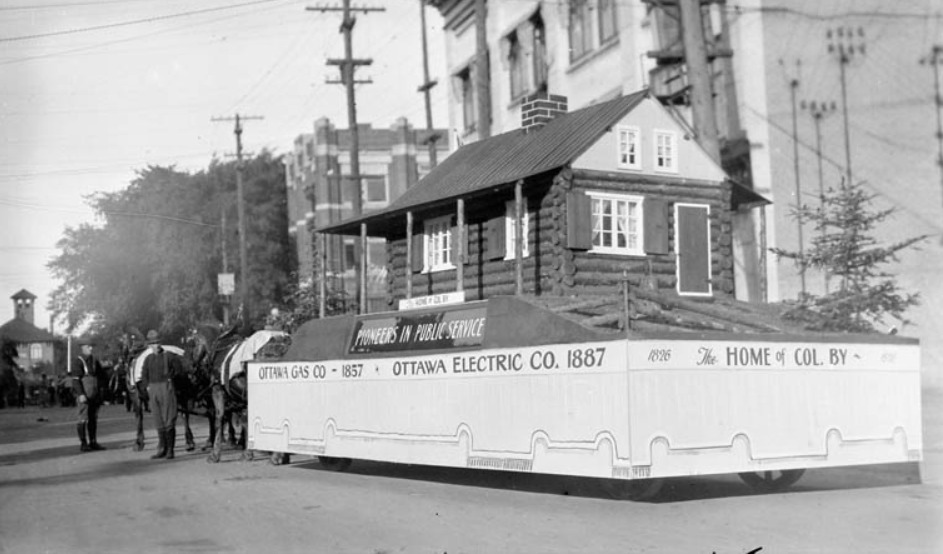 Float of the Ottawa Electric Company, Col. By’s Home, Trades & Industry Pageant, August 1926, Samuel J. Jarvis/Library and Archives Canada, PA-025127.
Float of the Ottawa Electric Company, Col. By’s Home, Trades & Industry Pageant, August 1926, Samuel J. Jarvis/Library and Archives Canada, PA-025127.
That evening, Ottawa’s merchants and businesses held the second of the week’s three parades. Starting in the Byward Market and ending at Lansdowne Park, the parade highlighted milestones of Ottawa’s commercial progress over the previous one hundred years. Among the many entries, the Producers’ Dairy’s float featured a huge milk bottle and milk maids. Camping equipment in 1826 and 1926 was the theme of the Grant Holden and Graham entry. Also in the parade was the largest shoe ever manufactured in Canada with six little girls seated inside it, courtesy of Ottawa’s boot and shoe stores. Representing the Ottawa Department Stores Association, four white horses with attendants dressed in white and yellow uniforms pulled a float bearing eight young women in long gowns. Not to be outdone, the A. J. Freiman entry, which was decorated in silver and flowers, was drawn by six white horses with six attendants dressed in white and blue livery. On board were five young ladies wearing period costumes. The Ottawa Electric Company float consisted of an (inaccurate) replica of Colonel By’s house. Instead of a pioneer’s log home as depicted, the Colonel’s actual home was made of stone.
With amusements and events continuing at the Exhibition Grounds, Thursday’s highlight was an “old timers’ parade. In front of immense crowds, historical floats, three bugle bands, three brass bands and one band of bagpipers wended their way slowly from the Byward Market, along Rideau and Sparks Streets before heading down Bank Street to Lansdowne Park. Old-time vehicles on display included an 1897 Oldsmobile and penny-farthing bicycles. Firefighters dressed in the red outfits of yore pulled hand reels or drove antique horse-pulled engines including the “Conqueror,” Ottawa first fire engine. There were also historical tableaux depicting the early days of the Ottawa Valley and Bytown, including Champlain and his men, the arrival of the Jesuits, the establishment of the first white settlement in the region by Philemon Wright, and the beginning of the lumber industry. Guests of honour in the parade included veterans from the Fenian Raids, the South African War and the Great War.
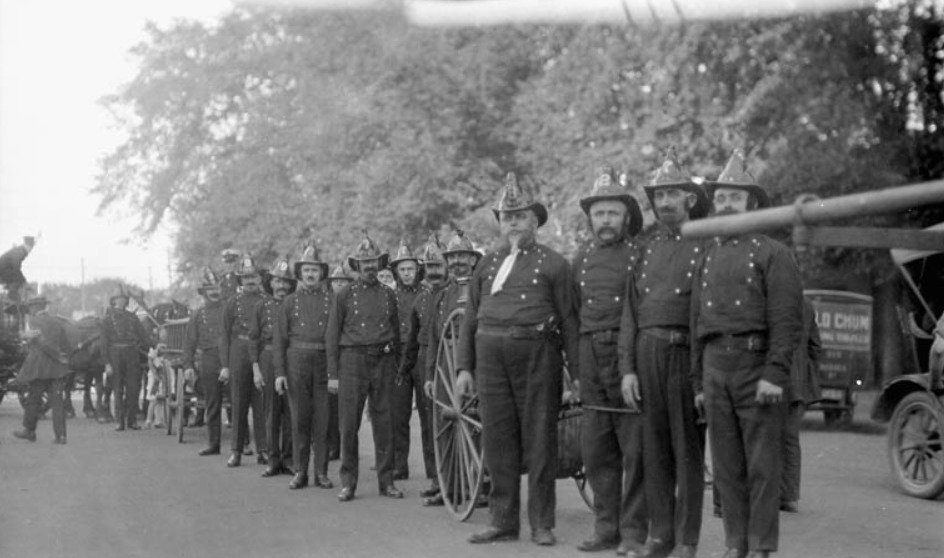 Ottawa Firefighters with hand reels, “Old-Time Pageant,” Ottawa Centenary, August 1926, Trades & Industry Pageant, August 1926, Samuel J. Jarvis/Library and Archives Canada, PA-025131.
Ottawa Firefighters with hand reels, “Old-Time Pageant,” Ottawa Centenary, August 1926, Trades & Industry Pageant, August 1926, Samuel J. Jarvis/Library and Archives Canada, PA-025131.
Centenary celebration wound down on the weekend but not before the finals of the stampede, more street dancing, this time in Hintonburg, more sporting activities, and a “Venetian Nights” boating event held on the Rideau Canal.
For those who hadn’t had their fill of fun and games, the Central Canada Exhibition opened immediately after the official ending of the centenary fun, prolonging the excitement for another week.
Both of Ottawa’s major newspapers covered in detail highlights of Ottawa’s first hundred years and centenary events, with each publishing extended supplements. The Evening Citizen boasted that its edition of 16 August weighed in at more than two pounds. It’s rival, The Ottawa Evening Journal, ran a close second. In one regard, however, the Journal went one step further by publishing a fascinating prospective view of what Ottawa might look like on its bicentenary in 2026. Some of its guesses look pretty accurate. It predicted that Ottawa would have a population of 975,000 (actual number 934,240 in 2016) and that it would annex neighbouring communities. It also correctly forecast the elimination of the above-ground, cross-city train tracks and the replacement of the tram lines with buses. It even predicted a tunnel between LeBreton Flats and downtown used by electric trains!
Not surprisingly, however, the crystal-ball gazers got a lot of things wrong. The newspaper predicted that Canada would have a population of 100 million by 2026, and that the airplane would effectively eliminate the automobile as a mode of transportation. The paper also postulated that after decades of delay the great Georgian Bay Ship Canal would finally be completed in 1982, almost eighty years after the idea was first proposed, thereby making Ottawa a deep-water port with direct access to the Atlantic Ocean. As well, given the region’s cheap hydro-electric power, the Journal envisaged a massive expansion of manufacturing in the Ottawa area, forecasting that the Capital would become the home of the largest Canadian plant for the manufacture of pleasure, commercial and air taxicabs. It also predicted the emergence of a large furniture manufacturing industry in Chelsea in West Quebec, and the construction of immense iron ore smelters in Ironside, just north of the old city of Hull, to process iron ore mined in the Laurentians.
For the Journal, the demise of manufacturing and the conversion of Ottawa into the primarily white-collar city that it is today were unimaginable.
Sources:
The Ottawa Evening Citizen, 1926. Various issues, 14-24 August.
The Ottawa Evening Journal, 1926. Various issues, 14-24 August.
Story written by James Powell, the author of the blog Today in Ottawa's History.
Retired from the Bank of Canada, James is the author or co-author of three books dealing with some aspect of Canadian history. These comprise: A History of the Canadian Dollar, 2005, Bank of Canada, The Bank of Canada of James Elliott Coyne: Challenges, Confrontation and Change,” 2009, Queen’s University Press, and with Jill Moxley, Faking It! A History of Counterfeiting in Canada, 2013, General Store Publishing House, Renfrew, Ontario. James is a Director of The Historical Society of Ottawa.
Canada’s Birthday 1 July 1867
1 July 1867
Each 1 July, Canadians across the country celebrate Canada’s birthday with cultural events and fireworks. The anniversary, which officially became Canada Day in 1982, was originally known as Dominion Day. Nowhere is the national holiday more sumptuously celebrated than in Ottawa, the nation’s capital. On the greensward in front of the Parliament buildings, thousands of patriotic Canadians flock to see the “Changing of the Guard,” performed by the Governor General’s Foot Guards dressed in their traditional scarlet tunics and bearskin hats. Canadian performing artists entertain the crowds through the day on a large stage specially erected for the occasion. After dusk, Parliament Hill is lit up with a dazzling display of fireworks.
Given this annual burst of patriotic fervour, it may come as a surprise that many Canadians don’t fully understand the event they are celebrating. Even officialdom gets it wrong. The Official Website of Ottawa Tourism, describes Canada Day as “the anniversary of Confederation, when Canada became a country separate from the British Empire.” Yes, 1 July is indeed the anniversary of Confederation. But no, Canada did not become separate from the British Empire on that date. Canadian legislative autonomy did not come until the Statute of Westminster in 1931, when the imperial government in London gave up its right to legislate for Canada and other Dominions. Even then, Canadians remained British subjects, and regarded themselves as members of the British Empire. Canadian legal decisions could also still be appealed to the Judicial Committee of the House of Lords in London, and Canadian constitutional changes required the consent of the British Parliament.
Instead of representing the birth of a new independent country, Canada Day marks the anniversary of the union of three pre-existing British colonies in North America—the Province of Canada, which itself was the result of the fusion of Upper and Lower Canada in 1841, Nova Scotia, and New Brunswick. The new entity was called the Dominion of Canada, hence, the original name for the holiday. The proclamation of the new Dominion by Queen Victoria on 1 July 1867 was the culmination of years of negotiations to unite the colonies of British North America. Motivated by a range of economic and political factors, including fears of annexation by their U.S. neighbour to the south, the “fathers of Confederation” had met in 1864, first in Charlottetown and later in Quebec City, to thrash out the details of forming a federation. After working out most provisions dealing with the country’s organization and the distribution of powers between the federal and provincial governments, a small group of nation-builders met in London, England in December 1866 to put the final touches on draft legislation to be submitted to the British Parliament. John. A. Macdonald had wanted the official name of the new federation to be the “Kingdom of Canada.” But at the eleventh hour, the British government, concerned about offending the republican government to the south, suggested “Dominion” as a less provocative style.
The British North America Act was first submitted to the House of Lords on 19 February 1867. There, the colonial secretary, Lord Carnarvon, opened the proceedings by saying: “We are laying the foundations of a great State, perhaps one that at a future date may even overshadow this country.” A week later, the bill was introduced into the House of Commons. The bill passed through the British Parliament without change, and was given Royal Assent on 29 March 1867, to take effect on 1 July.
The Act, which became Canada’s constitution, delineated the respective powers of the federal and provincial governments, and guaranteed minority rights, including linguistic rights. The Province of Canada was also split into its two component parts, allowing Canada West (Ontario) and Canada East (Quebec) to separately govern their own local affairs instead of together—a source of considerable strife during the previous twenty-five year existence of the Province of Canada. Some saw Confederation as a bulwark against U.S.-style democracy where majority rule could trump minority rights. The Ottawa Times declared that “The first of July, A.D., 1867, will ever be a memorable day in the history of this continent. It will mark a very solemn era in the progress of British America. By the Constitution which this day comes in force will be solved the great problem—a problem in which not we alone, but the whole world is intimately concerned—whether British constitutional principles are to take root and flourish on the Western Hemisphere, or unbridled Democracy shall have a whole continent on which to erect the despotism of the mob.”
The constitutional arrangement between the new Dominion and Great Britain remained unchanged from that which had existed prior to Confederation between the colonies in British North America and the mother country. Like the colonial governments that had preceded it, the new Dominion government was responsible for domestic affairs, while the imperial government in London retained responsibility for foreign affairs. The imperial government (or more correctly the Crown on the advice of the imperial government) also continued to appoint the governor general as it had done previously for each of the colonies, and retained its right to override Canadian legislation. Consequently, when the new Dominion was born on 1 July 1867, it remained an integral part of the British Empire, its government subordinate to the imperial government in London.
The birth of the new Dominion of Canada was greeted with great enthusiasm in Ottawa. Selected by Queen Victoria in 1857 as the capital of the Province of Canada, it was now the capital of a far larger political entity; few had doubts that the remaining British colonies in North American would join the new Dominion, building a country that spanned the continent. This took some time, however; Newfoundland and Labrador, the last to join, didn’t sign up until 1949.
In Ottawa, the partying started the night before the big day as people made their way to Major’s Hill to welcome in the new Dominion at midnight. At the stroke of twelve of the Notre Dame Cathedral clock, a huge pyramidal bonfire made of firewood and tar barrels, surrounded by a ring of boulders to protect spectators, was set ablaze. Thousands of Ottawa citizens, including the Mayor and members of the city council, gave “three hearty cheers,” for the Queen, and three more for the new Dominion of Canada. Churches throughout the city rang their bells, while the Ottawa Field Battery at the drill shed in Lower Town gave a 101-gun salute to the new country. Rockets and Roman candles lit the sky. Paul Favreau and his band played music to the crowd until dawn.
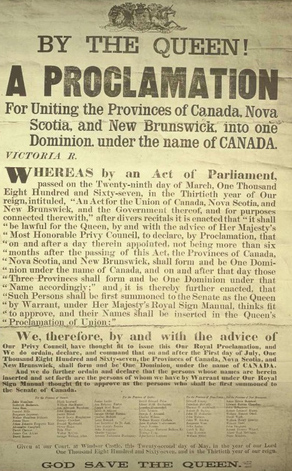 Proclamation announcing the formation of one Dominion, under the name of CANADA, 1867With the arrival of daylight on Monday 1 July 1867, the city “never looked better” to greet the thousands of visitors that were streaming into the capital from the countryside to join in the festivities. Bunting, flags, and streamers decorated public and private buildings alike along Sparks, Rideau and Sussex streets. At 7am, a lacrosse tournament between the Huron and Union Clubs commenced on Ashburnham Hill, the area east of today’s Bronson Avenue, between Lisgar Street and Laurier Avenue. At 10am, an honour guard from the Rifle Brigade took up position in front of the East Block on Parliament Hill to await the arrival of Lord Monck, the newly designated governor general of the Dominion of Canada. A half hour later, a salute from the Field Battery announced Monck’s appearance who was received by guards with presented arms. At 11am, the Queen’s proclamation was read out by Ottawa’s mayor. Dignitaries then entered the Executive Council Chamber. Monck, in plain clothes, advanced to the head of the Council table, read the Royal Instructions making him Governor General, and was sworn in by Canada’s Chief Justice. After the various oaths, the Field Battery on Major Hill’s gave another salute. The Governor General then conferred the title of Knight Commander of the Order of the Bath on John A. Macdonald for his contribution to making Confederation a reality. Several others received knighthoods of lesser orders. George-Étienne Cartier, Macdonald’s partner, was also offered a knighthood, but he refused it on the grounds it was inferior to that awarded to Macdonald. The following year, Cartier was made a baronet, a more illustrious honour, which also carried the title “Sir.”
Proclamation announcing the formation of one Dominion, under the name of CANADA, 1867With the arrival of daylight on Monday 1 July 1867, the city “never looked better” to greet the thousands of visitors that were streaming into the capital from the countryside to join in the festivities. Bunting, flags, and streamers decorated public and private buildings alike along Sparks, Rideau and Sussex streets. At 7am, a lacrosse tournament between the Huron and Union Clubs commenced on Ashburnham Hill, the area east of today’s Bronson Avenue, between Lisgar Street and Laurier Avenue. At 10am, an honour guard from the Rifle Brigade took up position in front of the East Block on Parliament Hill to await the arrival of Lord Monck, the newly designated governor general of the Dominion of Canada. A half hour later, a salute from the Field Battery announced Monck’s appearance who was received by guards with presented arms. At 11am, the Queen’s proclamation was read out by Ottawa’s mayor. Dignitaries then entered the Executive Council Chamber. Monck, in plain clothes, advanced to the head of the Council table, read the Royal Instructions making him Governor General, and was sworn in by Canada’s Chief Justice. After the various oaths, the Field Battery on Major Hill’s gave another salute. The Governor General then conferred the title of Knight Commander of the Order of the Bath on John A. Macdonald for his contribution to making Confederation a reality. Several others received knighthoods of lesser orders. George-Étienne Cartier, Macdonald’s partner, was also offered a knighthood, but he refused it on the grounds it was inferior to that awarded to Macdonald. The following year, Cartier was made a baronet, a more illustrious honour, which also carried the title “Sir.”
At noon, a massed military display was held on Parliament Hill, consisting of the Rifle Brigade, the Civil Service Rifles, the Carleton 43rd Infantry, the Ottawa Provisional Battalion of Rifles, the Ottawa Provisional Brigade of the Garrison Artillery, and the Ottawa and Victoria Cadet Corps. The show was slightly marred when the Civil Service Rifles fired a “feu de joie,” a sort of grande finale. Unfortunately, the order to “Fire” was not preceeded by the command “Remove ramrods.” A volley of ramrods was launched from Parliament Hill, across Wellington Street, to land in a hail of sparks on Sparks Street.
The military display was followed by athletic games on Major Hill. Games included the “standing” and “running” leaps, the 100-yard dash, as well as boat and canoe races. Across the city, a lunch was provided to the Carleton Infantry by Alderman Rochester at his own expense. The previous night, he had heard that the men would be arriving from the country for the parade and festivities without any refreshment organized for them. The alderman hosted the men and their families outdoors at his home, determined to rescue the “fair name of the city from the charge of want of hospitality.” More sporting events were held in New Edinburgh, including some unusual ones—a three legged race, a blindfold race, and a cricket ball throwing contest.
In the evening, another bonfire was lit, this time at Ashburnham Hill. Twenty-two cords of wood were sent up in flames. After dusk, fireworks were launched at Parliament Hill. Across the water in Hull, people picnicked as they watched the display. Music and dancing continued to the wee hours of the morning before Ottawa’s populace returned home exhausted, citizens of a new Dominion.
Sources:
Dictionary of Canadian Biography, 2014. “Cartier, Sir George-Étienne, http://www.biographi.ca/en/bio/cartier_george_etienne_10E.html.
Foster, Robert, Capt.et al, 1999. Steady the Buttons, Two by Two, Regimental History of the Governor General’s Foot Guards, Ottawa.
Story written by James Powell, the author of the blog Today in Ottawa's History.
Retired from the Bank of Canada, James is the author or co-author of three books dealing with some aspect of Canadian history. These comprise: A History of the Canadian Dollar, 2005, Bank of Canada, The Bank of Canada of James Elliott Coyne: Challenges, Confrontation and Change,” 2009, Queen’s University Press, and with Jill Moxley, Faking It! A History of Counterfeiting in Canada, 2013, General Store Publishing House, Renfrew, Ontario. James is a Director of The Historical Society of Ottawa.
Queen Victoria’s Diamond Jubilee
22 June 1897
Queen Victoria was our longest reigning monarch until her record of 63 years, seven months was eclipsed by that of Queen Elizabeth II in 2015. When Victoria celebrated her Diamond Jubilee, marking 60 years on the throne in 1897, the British went wild with joy. They had lots to celebrate. During her reign, Britain had been transformed. The nation had undergone an industrial revolution that had sharply raised national income. Electricity illuminated city streets and was beginning to light British homes. The telephone and the telegraph provided rapid communications, while railways and fast steamships moved people and goods effectively and efficiently around a British Empire that covered a sixth of the globe. This is not to say Victoria personally had much to do with all this, but she was the symbol of British achievement. There were clouds on the horizon, however. Germany and the United States were both challenging Britain on multiple fronts. And trouble was brewing in South Africa with the Boers. But in that glorious summer of 1897, Britain was on top of the world, economically, militarily, and politically. The Queen’s 60th anniversary on the throne was a good opportunity to celebrate. Although the actual anniversary date of her accession was Sunday, 20th June 1897, the official celebrations took place on Tuesday, 22nd June—declared an Empire-wide holiday.
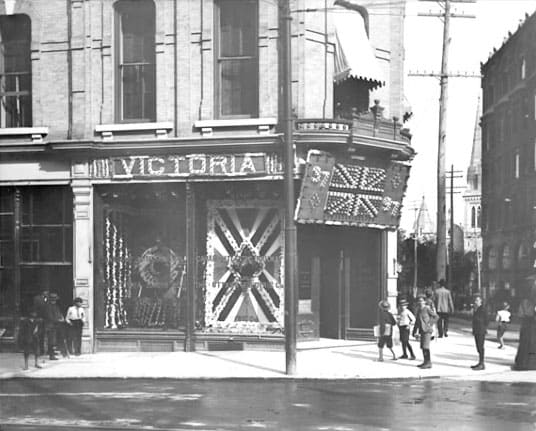 SE Corner of Sparks & Elgin, Front entrance of the office of the Canada Atlantic Railway Company
SE Corner of Sparks & Elgin, Front entrance of the office of the Canada Atlantic Railway Company
Topley Studio, Library and Archives Canada, PA-027878In Ottawa, preparations for the celebrations began weeks before the big day. The Capital bedecked itself in festoons of red, white and blue bunting and flags. For the patriotically minded, John Murphy & Co. sold bunting at 5 1/2 cents per yard. Large flags went for 15 cents, while a bust of the Queen could be had for 39 cents, marked down from 75 cents. For those who could afford it and were connect to the grid, electric lights were the way to go. Thousands of electric lights were strung along streets, and on store fronts at a cost of 10 cents per light, and 25 cents per light installation. So many were the lights, they strained the capacity of the Ottawa Electric Company. On Parliament Hill, the Centre Block was completely illuminated. Above the main entranceway into the Victoria Tower was a massive circle of lights surmounted by a crown, enclosing the letters “V.R.I.” for Victoria Regina Imperatrix. On the top floor of the far western tower was a crown surrounded by a circle of lights. In the three small windows beneath was “1837.” This was matched by a circle of lights around a star with “1897” in the three small windows in the second western tower. Between the two dates were the words “Dieu sauve la Reine.” This decorative motif was repeated on the eastern side of the building but with the words “God save the Queen.”
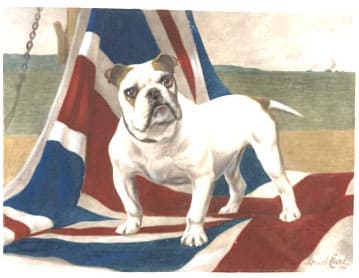 Dimboola, the mastiff, by Maud Earl "What we have, we'll hold
Dimboola, the mastiff, by Maud Earl "What we have, we'll hold
Canadian War Museum, 1896City streets were also illuminated. According to the Journal newspaper, “Sparks Street never looked gayer.” Flags lined both sides of the thoroughfare. Coloured streamers crossed the street from Sappers’ bridge to the Upper Town market (Lyon Street).” A “myriad” of lights lit up the street “like stars along the milky way.” The best display was reportedly at the office of the Canada Atlantic Railway at the corner of Sparks and Elgin Streets. Picked out in red, white and blue lights was a Union Jack over the front door, with the figures “37” and “97” on either side. The lights switched on and off giving the impression that the flag was waving. The words “Victoria” and “Regina” were written in electric lights at the top of the store windows on either side of the main door. In the Sparks Street window was the front of a railway engine, its cowcatcher covered with lights. On the front of the boiler were the dates 1837 and 1897 below the letters “V.R.” Next to the engine was the Queen’s portrait in a diamond-shaped frame surrounded by lights.
Wilson & Sons Art Store on Sparks Street displayed a striking patriotic print of a painting by Maud Earl of the mastiff champion “Dimboola” standing defiantly on a Union Jack with war ships in the background. The inspiration for the painting was a speech by Joseph Chamberlain, a popular British imperialist, in the House of Common in London who said “What we have we’ll hold.” The print was later purchased by Colonel Sherwood and given to the officers’ mess of the 43rd Battalion stationed in Ottawa.
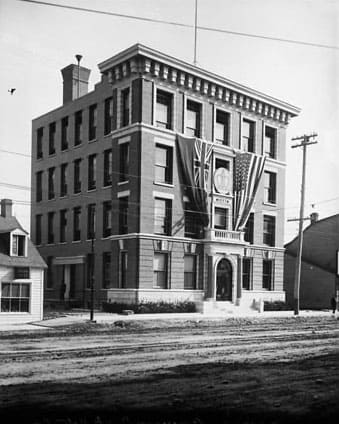 Queen Victoria Jubilee American Bank Note Company
Queen Victoria Jubilee American Bank Note Company
Topley Studio LAC-PA-027912The bank buildings that lined the south side of Wellington Street were also decorated in electric lights. Most chose variants of “V.R.I.,” crowns, or stars. The Union Bank had both, adding the words “The Queen God Bless Her” for good measure. The Quebec Bank was a bit more original opting for a diamond surrounding the figure “60.” The American Bank Note Company was decorated by two large flags, one British and one America on either side of an electrically-lit crown. On Elgin Street, Ottawa’s city hall was decorated with a large crown inside a circle of electric lights as well as “chromos” (colour prints) of the Queen and various British emblems, with flags, colourful bunting and festoons of lights.
British American Bank Note Company, Wellington Street, decorated for Queen Victoria’s Jubilee, June 1897. Note that the street is not asphalted. Topley Studio, Library and Archives Canada, PA-027912.
Jubilee celebrations began on the Saturday with the release of Canada’s first issue of commemorative stamps–two portraits of the Queen, one as a teenager on her accession and the other as an elderly woman. There was a huge crush of people at the Ottawa post office all trying to buy stamps as souvenirs. Many went home disappointed as the supply was very limited, especially of the one half and six cent stamps. All were gone within an hour of the post office’s opening. Reportedly, premiums were being paid by people to acquire them.
On the Sunday, the actual anniversary of Queen Victoria’s accession, churches across the city held Thanksgiving Services. That afternoon at 4pm, the Sons of the Empire sang God Save the Queen. Orders had gone out to all the lodges around the Empire to sing at that hour, starting in Fiji, “the exact antipodes to England.” Afterwards, the Sons of the Empire and other societies, including the Caledonian Society and the Boys’ Brigade, marched in a parade through Ottawa streets.
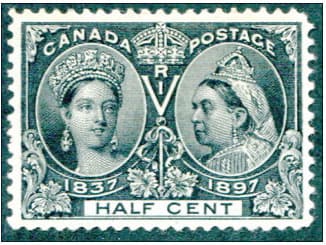 Queen Victoria 1/2 cent Canadian postage stamp, Canadian Commemorative Issue for Queen Victoria's Diamond Jubilee, 1987On that Sunday, the Evening Journal ran a fascinating story on the reminiscences of old timers looking back at Queen Victoria’s accession to the Crown in 1837. Captain Thomas Jones, who arrived in Bytown in 1827 as a young boy, recounted that the news reach the community six or seven weeks after the event. At that time, Bytown boasted a population of just 2,000 souls—300-400 in Upper Town and 1,600-1,800 in Lower Town—apart from the “canallers” who lived in mud and wooden shanties along the canal. Jones recalled that some soldiers would have preferred her uncle, the Duke of Cumberland, to have become the Sovereign. They expressed “strong feelings against a woman, especially a young one,” assuming the Crown. Paradoxically, he added that “loyalty was always prominent.” Rev. John Gourley of Nepean Street said Bytown residents were “reaping the wheat and saving the last of the hay” when the news finally reached them. In church, people were still praying for health of the old king, and the royal family, including Princess Victoria. The news, when it finally came, was, however, overshadowed by the Rebellion of 1836-37. But “there was not a man in the land so rebellious as not to pray sincerely for the best health, longest peaceful reign, and the greatest prosperity.” He added that in 1837 the city centre was a duck pond, Bank Street was a cedar and ash swale, and the garrison just a few stone huts. Another senior citizen, John Joyce of Henry Street, recalled that a celebratory bonfire had been lit at the corner of Nicholas and Rideau Streets, and everybody was there. “Cheer after cheer went up in honour of the youthful Queen.”
Queen Victoria 1/2 cent Canadian postage stamp, Canadian Commemorative Issue for Queen Victoria's Diamond Jubilee, 1987On that Sunday, the Evening Journal ran a fascinating story on the reminiscences of old timers looking back at Queen Victoria’s accession to the Crown in 1837. Captain Thomas Jones, who arrived in Bytown in 1827 as a young boy, recounted that the news reach the community six or seven weeks after the event. At that time, Bytown boasted a population of just 2,000 souls—300-400 in Upper Town and 1,600-1,800 in Lower Town—apart from the “canallers” who lived in mud and wooden shanties along the canal. Jones recalled that some soldiers would have preferred her uncle, the Duke of Cumberland, to have become the Sovereign. They expressed “strong feelings against a woman, especially a young one,” assuming the Crown. Paradoxically, he added that “loyalty was always prominent.” Rev. John Gourley of Nepean Street said Bytown residents were “reaping the wheat and saving the last of the hay” when the news finally reached them. In church, people were still praying for health of the old king, and the royal family, including Princess Victoria. The news, when it finally came, was, however, overshadowed by the Rebellion of 1836-37. But “there was not a man in the land so rebellious as not to pray sincerely for the best health, longest peaceful reign, and the greatest prosperity.” He added that in 1837 the city centre was a duck pond, Bank Street was a cedar and ash swale, and the garrison just a few stone huts. Another senior citizen, John Joyce of Henry Street, recalled that a celebratory bonfire had been lit at the corner of Nicholas and Rideau Streets, and everybody was there. “Cheer after cheer went up in honour of the youthful Queen.”
Tuesday, 22 June 1897 dawned to perfect weather—bright sunshine, warm and a refreshing breeze, though later there were some complaints of dust kicked up from unwatered city streets. (Most streets were still unasphalted.) At 7.59am, the bells at St. Patrick’s church began ringing, followed by those at St. George’s, and the Basilica. Within moments, thirty churches had joined in the peel. The whistle at E.B. Eddy’s then began to blow, and was shortly joined by factory and shop whistles across the city, followed locomotive horns at the train depots. The church bells continued at intervals for the next half hour, while the E.B. Eddy whistle went continuous for nine minutes. Adding to the cacophony was the barking of dogs and the shouting and cheering of Ottawa residents standing in front of their homes waving flags.
At 9am, a 1,000-man parade of the St. Jean Baptiste Society set out on a procession through the streets of Ottawa after a celebratory Mass at the Basilica to demonstrate “what loyalty exists in the hearts of French Canadians towards Her Majesty the Queen.” At the head of the procession was Monsieur F. Laroque, the grand marshal of the Society as well as the grand marshals of the Artisans. The Saint Anne band played marching tunes while various other societies that had joined the parade carried banners and flags.
Later in the day, 8,000 children—6,000 from Ottawa and 2,000 from Hull—dressed in white or pale blue with red, white and blue trimmings, waving tiny Union Jacks, assembled on Parliament Hill. The Upper Town children had walked from Central West School with each class headed by their teacher, and each school headed by their principal. Lower Town children began their march to the Hill from the Byward Market. Separate school children were led by grey-gowned nuns. The children took their position on either side of the central walkway in front of the Centre Block where a large decorated stage had been erected. The dignitaries present for the event included the Governor General, Lord Aberdeen and senior Cabinet ministers, and civic leaders. Wilfrid Laurier, the Prime Minister, was absent. He was in London participating in the Queen’s parade as a guest of honour. He was knighted the same day.
Lord Aberdeen, wearing the uniform of a Lord Lieutenant with the star of a baronet of Nova Scotia and other honours pinned to his chest, spoke to the children and a crowd of 25,000 people about the Queen’s life of service, her dedication to duty, and the example she set for others. He also read out loud the Queen’s blessings and thanks to “my beloved people” in Canada, that he had received earlier that morning. Following a tremendous cheer from the crowd, he read out his response saying that Her Majesty’s “most gracious and touching message” will “stir afresh hearts already full.” To provide a lasting tribute to the Queen, Lord Aberdeen announced the establishment of the Victorian Order of Nurses to be dedicated to help and relief of the sick and lonely.
Following other speeches, Professor Birch of the College of Music stood on a chair and raised his baton—the signal for the Bandmaster McGillicuddy of the 43rd Battalion to sound the key for the National Anthem. Upon the third beat, the massed choir of children from Ottawa and Hull began to sing “God Save the Queen.” After singing the anthem twice through, “three cheers” were given to the Queen and Lord Aberdeen.
Later at Cartier Square by the Drill Hall, the 43rd Battalion held an inspection and completed complicated military practices, including sword drill, pursuit exercises on horseback, and independent firing drill. The battalion, accompanied by a company of Fenian Raid veterans, also did a “march past.” Crowds of onlookers stood five and six persons deep around the Square to witness the military manoeuvres. The Journal commented that “the main part of the rising generation occupied reserved seats on the trees and telephone poles.” Lord Aberdeen presented the Royal Humane Society medal to Pte Douglas Lyon of the 43rd Battalion for bravery in attempting to save the lives of two young boys who drowned after falling through the ice while skating on the Rideau Canal at the end of November the previous year. This was followed by a 21-gun Royal Salute by the Ottawa Field Battery from Nepean Point.
The afternoon of Jubilee Day was taken up by sporting events at Lansdowne Park, including a lacrosse match between the Capitals and the Shamrocks. The Capitals emerged victorious 6-1. After sundown, Ottawa residents and visitors strolled around downtown streets to admire the illuminated buildings. There was, however, a lighting glitch on Parliament Hill. When the lights were switched on shortly before 9pm, a portion stayed dim. Fortunately, the problem was quickly rectified. Musical entertainment was provided on the big stage in front of the Centre Block. Madame Arcand opened, singing a solo of The Land of the Maple. She was joined by a 300-voice choir. Other patriotic songs sung by other vocalists included: Hearts of Oak, British Tailors’ Toast and, of course, Rule Britannia. Mr. Choquette MP followed with Dieu Brigadier in French. A Highland Pipes band also played a number of tunes, followed by Scottish dances.
At 10pm, the fireworks began at Cartier Square. Paper balloons were sent up into the sky with multi-coloured lights attached to them. In addition to the usual rockets, and “whiz bang bombs” that exploded in red, white, blue and green stars, there were a number of set pieces on the ground. This included a triple wheel that changed colour, Prince of Wales feathers with red fire coming out of the top of each feather, and a diamond jewel. The piece de resistance was a double head of Queen Victoria thirty feet long and 20 feet high with the motto “Our Queen of 60 years, 1837-1897” at the base. The double head, which constantly changed colour, remained lit for five minutes as the band struck up God Save the Queen. For the grand finale, the words “Good night” were spelt out while sky fifty rockets exploded overhead.
Queen Victoria died on 22 January 1901.
Sources:
Evening Journal, 1896. “Sank To Death Together,” 1 December.
——————–, 1897, “John Murphy & Co.” 18 June.
——————–, 1897. “Will Follow The Beat of The Drum,” 19 June.
——————–, 1897. “Oh! Did You Get One?” 19 June.
——————–, 1897. “With United Vocies,” 19 June.
———————-, 1897. “Remember the Day the Queen Was Crowned,” 21 June.
———————-, 1897. “Pulpit Tributes to the Queen,” 21 June.
———————-, 1897. “The Jubilee Has Begun,” 21 June.
———————-, 1897. “The Capital Celebrates,” 23 June.
———————-, 1897. “City Illuminations,” 23 June.
———————-, 1897. “The Fireworks,” 23 June.
———————-, 1897. “Ten Thousand Lights,” 24 June.
———————-, 1897. “An Impressive Potrait,” 24 June.
Ottawa Citizen, 1897. “A Striking Picture,” 22 June.
——————, 1897. “god Save The Queen,” 22 June.
VON Canada, 2018, About VON.
Story written by James Powell, the author of the blog Today in Ottawa's History
Retired from the Bank of Canada, James is the author or co-author of three books dealing with some aspect of Canadian history. These comprise: A History of the Canadian Dollar, 2005, Bank of Canada, The Bank of Canada of James Elliott Coyne: Challenges, Confrontation and Change,” 2009, Queen’s University Press, and with Jill Moxley, Faking It! A History of Counterfeiting in Canada, 2013, General Store Publishing House, Renfrew, Ontario. James is a Director of The Historical Society of Ottawa.



